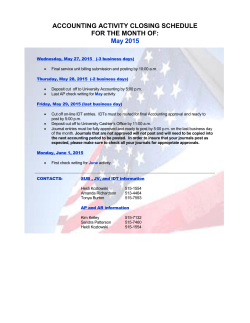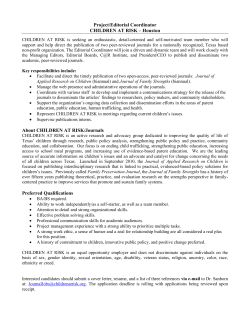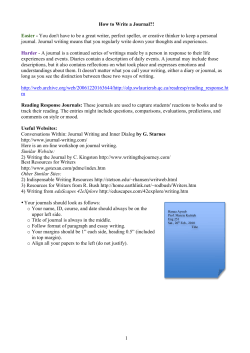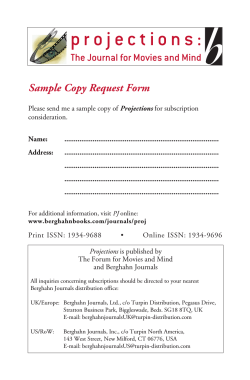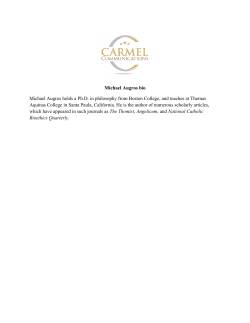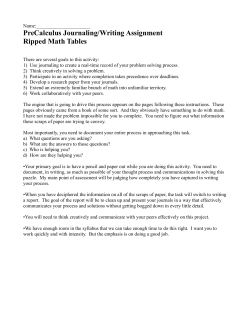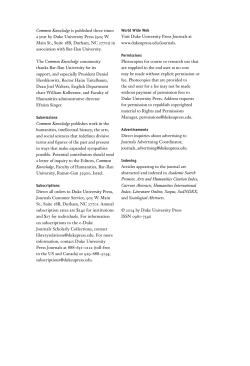
High-impact factor syndrome
High-impact factor syndrome: What, why, and what to do Carlton M. Caves Center for Quantum Information and Control, University of New Mexico Centre for Engineered Quantum Systems, University of Queensland http://info.phys.unm.edu/~caves 2015 May 1 This is an opinion piece, and the opinions are mine. Center for Quantum Information and Control Parable of the physics prize Holstrandir Peninsula overlooking Ísafjarðardjúp Westfjords, Iceland High-impact-factor syndrome (HIFS) High-impact-factor syndrome (HIFS) is a disease of scientists and administrators. The most virulent manifestation of the disease lies in judging the accomplishments of individual scientists, especially junior scientists, in terms of the number of publications in high-impact-factor (HIF) journals. C. M. Caves, “High-impact-factor syndrome,” APSNews 23(10), 8,6 (2014 November). Back-page opinion piece on HIFS. R. Werner, “The focus on bibliometrics makes papers less useful,” Nature 517, 245 (2010 January 15). Focus on use of citation metrics. PI Predictor, in Science Careers, a simplified version of original in Current Biology), as summarized by J. Austin, “What it takes,” Science 344, 1422 (2014 June 20): Be male. Be selfish (insist on being first author). Be elite (from one of the top ten institutions in the Shanghai Academic Ranking of World Universities). Publish in HIF journals. High-impact-factor syndrome (HIFS) is the practice of using number of publications in HIF journals as a proxy for individual research accomplishment or potential. San Francisco Declaration on Research Assessment (DORA): Putting Science into the Assessment of Research. Chief recommendation: Do not use journal-based metrics, such as Journal Impact Factors, as a surrogate measure of the quality of individual research articles, to assess an individual scientist’s contributions, or in hiring, promotion, or funding decisions. D. Hicks, P. Wouters, L. Waltman, S. de Rijcke, and I. Rafols, “Bibliometrics: The Leiden manifesto for research metrics,” Nature 520, 429–431 (2015 April 23): Several universities base promotion decisions on threshold h-index values and on the number of articles in “high-impact” journals. Researchers' CVs have become opportunities to boast about these scores, notably in biomedicine. Everywhere, supervisors ask PhD students to publish in highimpact journals … . In Scandinavia and China, some universities allocate research funding or bonuses on the basis of a number: for example, by calculating individual impact scores to allocate “performance resources” or by giving researchers a bonus for a publication in a journal with an impact factor higher than 15. High-impact-factor syndrome (HIFS) I am not talking about The general question of the purpose of scientific publication in the age of the arXiv. Whether you should publish your own paper in Nature or its babies, Science, or even PRL. The use of impact factor to judge the quality of a journal. The general use of citation metrics (bibliometrics) as a tool for assessing research accomplishment. Using publication in HIF journals as a proxy for assessing countries, states, institutions, and units within institutions. Although I will have something to say about each of these, because they are all related to HIFS. Parable of the two physicists Cable Beach Western Australia What is journal impact factor (IF)? How to get the 2013 IF for Physical Review Letters Take all the papers published in PRL in 2011 and 2012. The standard (two-year) 2013 IF is the average number of citations accumulated by these papers in 2013, in a list of “indexed journals” maintained by Thomson Reuters Web of Science. Web of Science indexes over 8,000 science and technology journals and issues an annual report, called the Journal Citation Reports (JCR), which lists IFs and other measures of journal impact. For example, you will also see fiveyear IFs, which are computed using a time horizon of five years instead of the two years for standard IF. For a given journal, IF (five-year IF) is the average annual citation rate for papers that are on average 1.5 (3) years old. 2013 IF Journal 2-year IF 5-year IF Nature 42.351 40.783 Nature Physics 20.603 20.059 Nature Photonics 29.958 32.342 Nature Medicine 28.054 26.501 Nature Geoscience 11.668 13.930 Nature Communications 10.742 11.023 Science 31.477 34.463 Cell 33.116 35.020 Reviews of Modern Physics 42.860 52.577 Physical Review Letters 7.728 7.411 Physical Review A 2.991 2.729 Physical Review B 3.664 3.564 Physical Review C 3.881 3.551 Physical Review D 4.864 4.046 Physical Review E 2.326 2.302 Physical Review X 8.385 New Journal of Physics 3.673 Lessons There is variation across Disciplines. Interdisciplinary journals vs. disciplinary journals. Types of articles. Review journals and those with a mix of article types vs. just research articles. Types of journals. Cherry-picking magazines vs. journals of record. - Variation across papers in any journal. Even if you love citation metrics, IF is a poor metric for assessing individuals. 3.678 Who ordered 4 or 5 figures? IF Research articles published in Nature Physics in 2011 and 2012 312 research papers 18,050 citations on Web of Science 57 citations/paper 2013 IF: 18.8 (compare to reported 20.6) 3.25 years since publication on average All 312 papers: 17.8 citations/paper-year The 38% of the papers with 58 citations or more account for 68% of the citations, with a rate of 32.6 citations/paper-year The bottom 50% of the papers have a citation rate of 7.4/paper-year Parable of the formal research assessment Pinnacles National Park Central California HIF incentive structure $$$$ Research institutions. $$ $$$ Governments and funding agencies. Research assessments The data are available: TR Web of Science Google Scholar Reputation Validation Scientists. Papers $ HIF journals. $$ Pre-massaged: Nature Index Nature index global Nature 515, S49 (13 November 2014) HIF incentive structure $$$$ Research institutions. $$ $$$ Governments and funding agencies. Research assessments The data are available: TR Web of Science Google Scholar Reputation Validation Pre-massaged: Nature Index And trumpeted Scientists. Papers $ HIF journals. $$ Nature index USTC Hefei ANU Canberra UQ Brisbane LMU München UT Austin Consequences of HIFS Poor decisions in hiring, funding, promotions, and prizes and awards, especially when administrators without technical expertise are inserted into the process or when an institution hires in a field new to it. Should we eschew bibliometric data in assessing research impact? Parable of the four QI theorists Articles Citations Per article h-index 131 10,913 83 45 130 9,248 71 45 187 7,890 43 41 90 7,563 84 42 Oljeto Wash Southern Utah Citation metrics The Leiden manifesto Nature 520, 429–431 (2015 April 23) 1. Quantitative evaluation should support qualitative, expert assessment. 2. Measure performance against the research missions of he institution, group, or researcher. 3. Protect excellence in locally relevant research. 4. Keep data collection and analytical processes open, transparent, and simple. 5. Allow those evaluated to verify data and analysis. 6. Account for variation by field in publication and citation practices. 7. Base assessment of individual researchers on a qualitative judgement of their portfolio. 8. Avoid misplaced concreteness and false precision. 9. Recognize the systemic effects of assessment and indicators. 10. Scrutinize indicators regularly and update them. Consequences of HIFS Poor decisions in hiring, funding, promotions, and prizes and awards, especially when administrators without technical expertise are inserted into the process or when an institution hires in a field new to it. Should we eschew bibliometric data in assessing research impact? Bibliometrics, used carefully within a suite of assessment tools and calibrated appropriately, can provide useful information in assessing an extended research record, as in promotion decisions. But hiring and funding decisions want a snapshot, weighted toward potential instead of accomplishment. This is where the temptation to succumb to HIFS is greatest, but it is marginally informative at best and likely useless as a measure of individual potential. You will be more likely to end up with individuals who can satisfy the institutional imperative for researchers who have high impact by doing a complete, well-rounded evaluation of individual research records. Consequences of HIFS Poor decisions in hiring, funding, promotions, and prizes and awards, especially when administrators without technical expertise are inserted into the process or when an institution hires in a field new to it. Surrender of the scientific research agenda to the editors of Nature and its babies, Science, and Cell. Fragmentation of the scientific literature into short, punchy, hit-and-run papers aimed at HIF journals. Literature becomes a jungle for students and junior researchers. Trend toward hype, fluff, and salesmanship as primary values in scientific research and a reduction in commitment to scientific integrity and the search for truth, the two things that set science apart as a social enterprise. Campbell’s law The more any quantitative social indicator is used for social decision-making, the more subject it will be to corruption pressures and the more apt it will be to distort and corrupt the social processes it is intended to monitor. D. T. Campbell, “Assessing the impact of planned social change,” Journal of MultiDisciplinary Evaluation 7(15), 3 (2011); originally published as Paper #8, Occasional Paper Series, Public Policy Center, Dartmouth College, December 1976. Gaming any single indicator is inevitable. View from Cape Hauy Tasman Peninsula, Tasmania Consequences of HIFS Poor decisions in hiring, funding, promotions, and prizes and awards, especially when administrators without technical expertise are inserted into the process or when an institution hires in a field new to it. Surrender of the scientific research agenda to the editors of Nature and its babies, Science, and Cell. Fragmentation of the scientific literature into short, punchy, hit-and-run papers aimed at HIF journals. Literature becomes a jungle for students and junior researchers. Trend toward hype and salesmanship as primary values in scientific research and a reduction in commitment to scientific integrity and the search for truth, the two things that set science apart as a social enterprise. Campbell’s law. Gaming and goal displacement. What to do? Western diamondback rattlesnake My front yard, Sandia Heights What to do? Appeals to good behavior Renew your commitment to effective scientific communication. When evaluating candidates for positions, promotions, and prizes or awards, commit to a technically informed evaluation of each candidate’s entire record. When writing letters of recommendation, write a technically informed evaluation of a candidate’s capabilities and impact, including a description and evaluation of important research. Educate administrators that the HIF shortcut, though not devoid of information, is only marginally useful. If you are a senior or mid-career scientist who advertises yourself by categorizing your publications in terms of HIF journals, stop doing that. Help the public-relations people at your institution to identify and publicize important research contributions, independent of where they are published. Take a look at the San Francisco Declaration on Research Assessment (DORA), which is aimed directly at combating HIFS. What to do? Include in ads for positions at your institution a standard statement along the following lines: “Number of publications in high-impact-factor journals will not be a factor in assessing research accomplishments or potential.” Support research by your social-science colleagues to develop a suite of effective and informative tools for assessing research accomplishment and potential. Tent Rocks Kasha-Katuwe National Monument Northern New Mexico
© Copyright 2025
